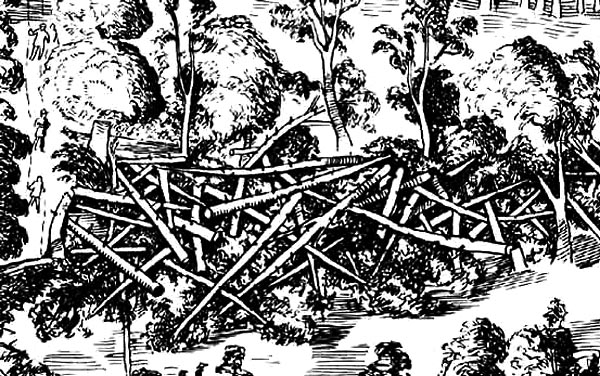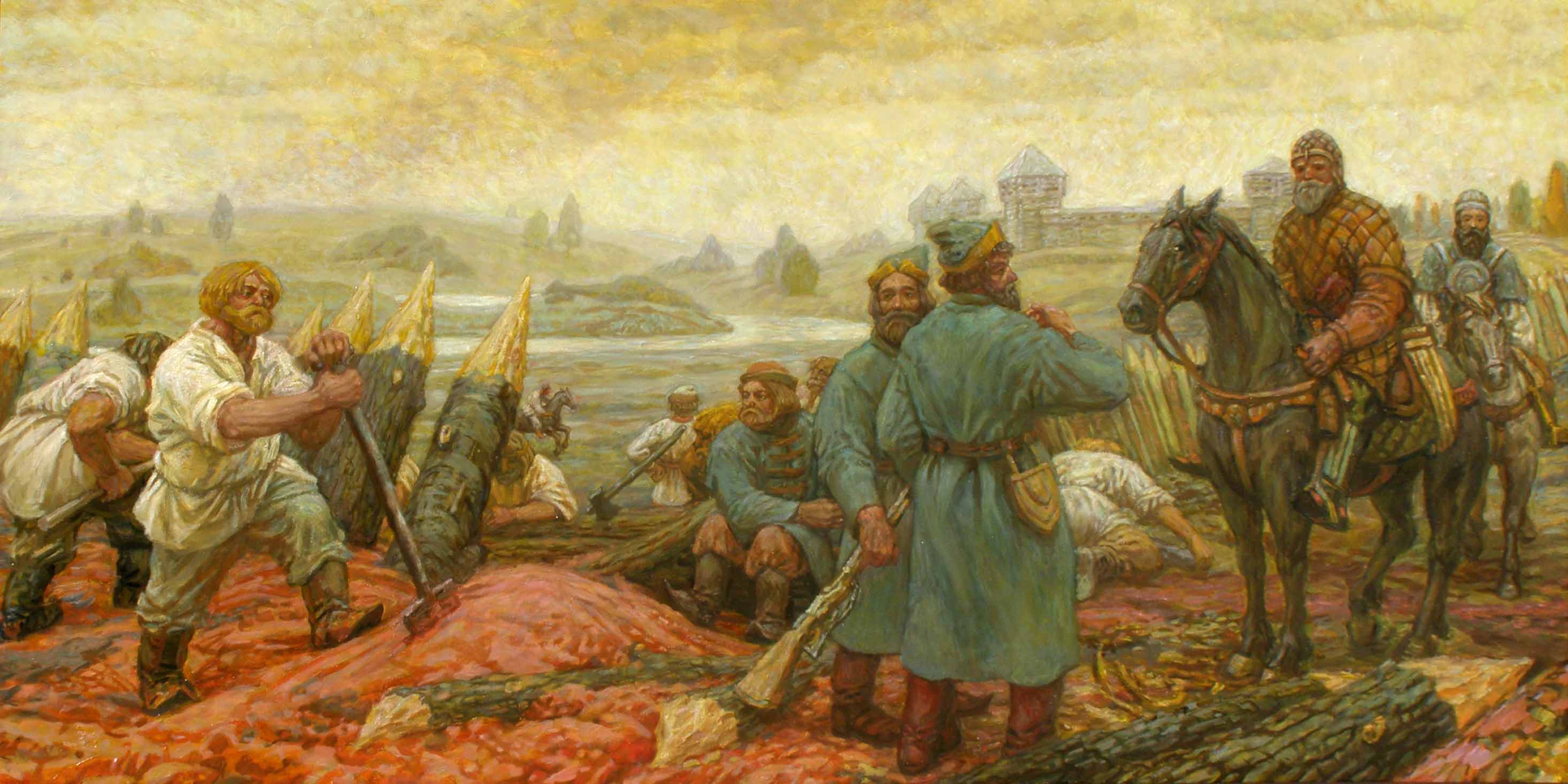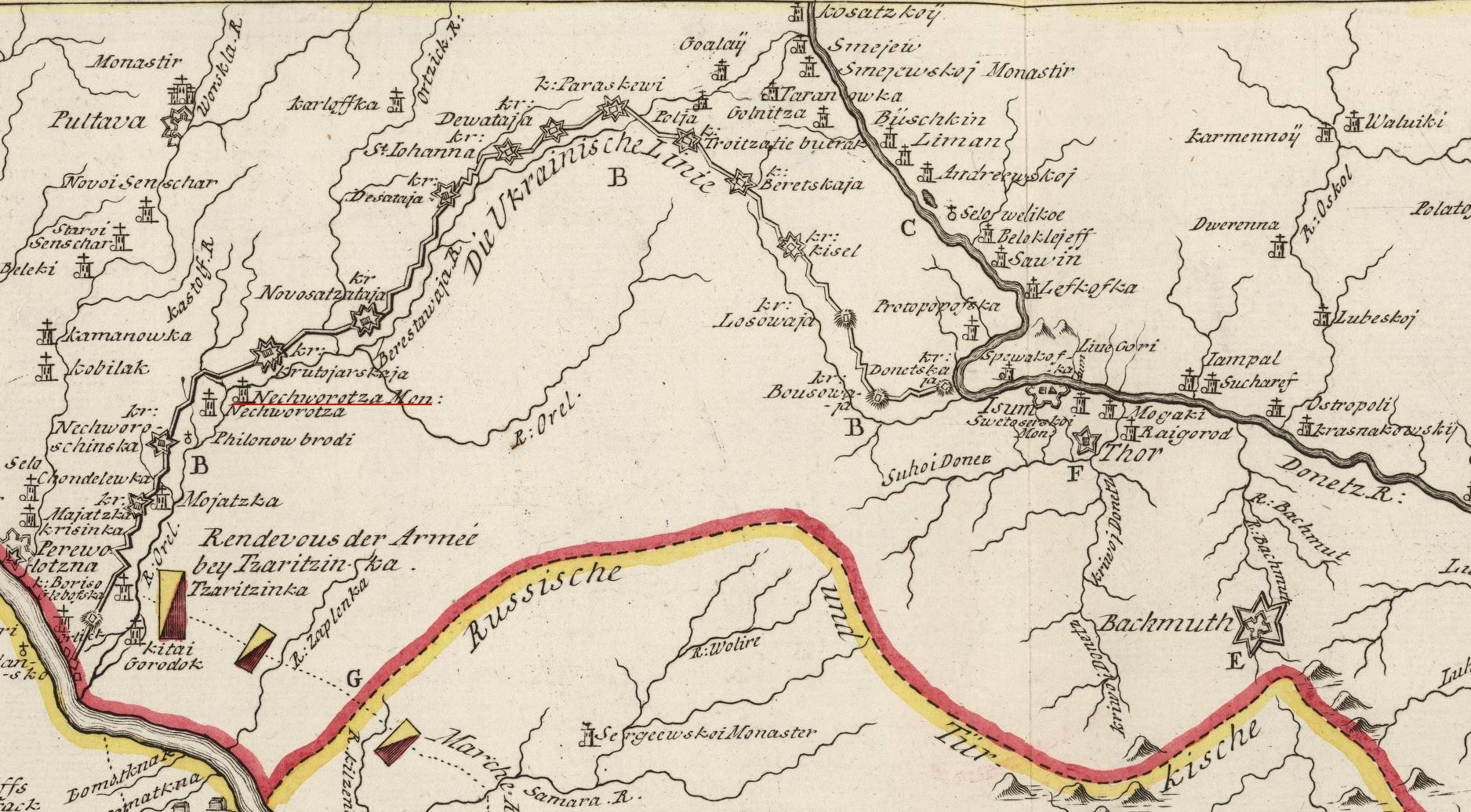The Potato War
Russia’s Border Walls
by Mike Bennighof, Ph.D.
February 2017
 When Russian Empress Catherine II cast covetous eyes to her southern borders, the lands north of the Black Sea known as the Pontic Steppe were enormously different than they would seem even a generation later. When Russian Empress Catherine II cast covetous eyes to her southern borders, the lands north of the Black Sea known as the Pontic Steppe were enormously different than they would seem even a generation later.
Most of what today is Ukraine was covered in grassland, known as the Pontic Steppe. While earlier peoples had at times broken the rich black soil and farmed it, in the 18th Century most of this lightly-populated region hosted herds of horses and sometimes cattle. It was a beautiful and wild land, the sort that gives rise to romantic legends.
For several centuries, the region between the Danube and the Volga had been an intersection of multiple cultures: the Islamic world in the guise of Crimean and Nogai Tartars, Western Christianity as represented by the Poles, Asiatic cultures such as the Buddhist Kalmyks, and the Orthodox Muscovite Russians. Catherine sought to bring Russian dominance to the region, completing a project first envisioned by Peter the Great in the late 1600’s.
 
The Steppe and Sky
of Ukraine
The opportunity for Russian expansion came with the decline of the two powers that had fought over the Pontic Steppe in the previous century. Poland had ruled over Ukraine until the disastrous events of the Deluge – Khmelnytsky Uprising of 1648, the Swedish invasion of 1655, and the civil disorder and Russian invasion that followed. The Commonwealth of Poland and Lithuania lost a third of its population and suffered massive destruction; it never recovered its great power status and began a spiral of decline that finally ended with partition between its neighbors.
The Ottoman Empire meanwhile faced a similar decline, beginning with its defeat in front of Vienna in 1683 – a defeat largely due to the intervention of Polish troops led by King Jan Sobieski. Habsburg armies, aided by German and Polish forces, steadily forced the Turks back out of Hungary, Slovakia, Croatia and Transylvania, culminating in the 1699 Treaty of Karlowitz. Ottoman Turkey would never again be a serious threat to Central Europe, while Austria had emerged as a great power.
Russian expansion at the expense of Islamic states had been an ongoing process, one marked not just by lines on a map but actual, fortified lines stretching across the empty steppe. The old principality of Muscovy had erected a fortified line along the Oka River south of Moscow by the 1400’s, and the strategy continued for the next three centuries.

The Abatis Line
The barrier inhibited Tartar slave raids, which would set out northward on long-establish cattle tracks, constantly fanning out into smaller and smaller tendrils until raiding parties advanced along a very broad front. The Tartars rounded up their captives, both humans and cattle, along with any other booty they had seized, and reunited at a designated rally point where the Khan could take his share. The horde then returned home.
The Muscovites next built what became known as the Abatis Line to the south of the Oka, fencing off still more territory. As the name implies, the line was made up primarily of intertwined wooden stakes to impede the advance of Tartar horsemen. Construction took place throughout the latter half of the 1500’s, with the tsars pouring massive resources into the program.
Despite the investment, Tartar raiders broke through in 1632 and devastated large swathes of territory. The Duma made up of leading Moscow nobles insisted that Tsar Michael do something to prevent a recurrence. The Abatis Line would be repaired and strengthened; the sector consisting merely of felled trees would be upgraded and all along the line the wooden obstacles would be backed by a ditch and a wall.

Building the Belgorod Line.
Some of the boyars wished the defensive perimeter pushed further southward, and in 1636 the Duma approved the Belgorod Line, a string of fortresses, blockhouses and smaller forts linked by a continuous earthen wall. The line would serve not only to keep Tartar raiders out, but also to keep recalcitrant serfs in. A few fortresses incorporated into the line had been built in the late 1500’s, but most of the works were new construction. The line included eighteen fortress-towns and initially stretched for slightly more than 800 kilometers, and would be extended several times to both east and west in the following decades. The expense of building a new line while repairing the old one became excessive, and in 1638 Tsar Michael ordered that the Abatis Line be abandoned and all effort put into the Belgorod Line.
A border wall is useless without a garrison to protect it, and a permanent garrison is expensive: if the entire wall isn’t manned, then those trying to cross it will simply seek out the places that aren’t covered and cross there. And the garrison has to be present at all times, whether someone’s trying to cross the wall or not.
The Russians solved that problem by stationing settle-soldiers along the wall, who received plots fo land in exchange for their military service, and also exemptions from taxation and the other burden faced by Russian serfs. They also had the theoretical right to hold serfs of their own, though the odds of any such soldier accumulating enough wealth to buy a serf were very low.
The wall’s guardians received very few benefits: a relatively small parcel of land compared to the service land grants of old Muscovy (including those for defenders of the Abatis Line), a much smaller cash bounty than that offered regular soldiers, and a lack of peasant tenants on their land to do the work of farming. In exchange, they would not be expected to perform any duties beyond guarding the wall. But within a few years the Tsar’s government had reneged on that promise, drafting border troops into the field armies.
Peter the Great extended the fortifications to the south with new fortresses along the river Don. He also expanded the obligations of the Land Militia, as the frontier troops were now called. Like other peasants they paid the “soul tax,” provided recruits to the regular army (beyond those called into the Land Militia), provided food and fodder to the army and performed unpaid feudal labor on the fortresses and the border wall. On the positive side, the rich soil of the Black Earth region through which the line ran proved enormously more productive than the thing clay found closer to Moscow.
Having studied modern fortifications in Western Europe, Peter incorporated the basic design principles into the Belgorod Line. The fortresses now became modern stone constructions with Vauban-style bastions and outer works. The wall itself became higher and wider, topped with a wooden palisade and fronted by a ditch.

The Ukrainian Line between the Dnepr and the Donets, in a 1745 German map.
In 1718 Peter ordered work on a new line still further to the south, linking the Don and Volga rivers at Tsaritsyn. The Tsaritsyn Line was declared complete two years later, and in 1731 work began on a lengthy extension to the west known as the Ukrainian Line. Field Marshal Burkhard Cristoph von Münnich, charged with reforming the Russian Army, saw the new line not only as a defensive bastion but an offensive base as well. He enlarged the fortresses under construction in the Ukrainian Line so they could shelter troops and magazines of food and munitions. To garrison the Line, Land Militia regiments were transferred southward from the old Belgorod Line.
With forward operating bases right on the edge of Russian territory, Münnich was able to execute the first successful Russian war against the Ottomans and their Tartar allies in the 1736-1739 Crimean War. Münnich’s army broke into the Crimean Peninsula itself and ravaged the Tartar heartland, but the battlefield failures of Russia’s Austrian allies caused an early peace that returned most of the conquests to the Turks and Tartars.
When war returned to the Pontic Steppe in 1768, the Russian armies again had a well-fortified, well-supplied set of forward operating bases available directly on the front lines. While Ottoman and Tartar armies had to assemble hundreds of miles away from the front, the Russians could do so directly on the frontier even though they operated even further from their homeland than did their enemies. When combined with the new mobile magazines with thousands of ox-drawn wagons, this gave the Russians an enormous logistical advantage.
Russia’s border walls proved enormously expensive, and ultimately solved the problem of Tartar raids not by repelling the invaders but by helping to project power into enemy territory. As passive defenses, they were somewhat successful when balanced against their great cost, but as forward operating bases they proved decisive.
Note: Our Soldier Kings: The Potato War expansion book is built around two conflicts that took place in the latter half of the 18th century: the Russo-Ottoman War of 1768 and the Potato War of 1778.
Click here to order The Potato War right now.
Mike Bennighof is president of Avalanche Press and holds a doctorate in history from Emory University. A Fulbright Scholar and award-winning journalist, he has published over 100 books, games and articles on historical subjects.
He lives in Birmingham, Alabama with his wife, three children and his dog, Leopold.
|
